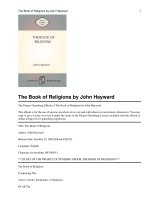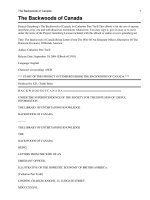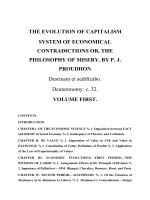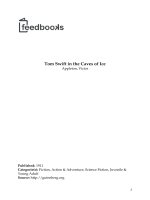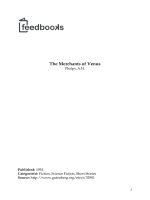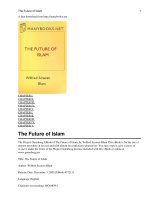THE CONSTITUTION OF LAW Legality in a Time of Emergency potx
Bạn đang xem bản rút gọn của tài liệu. Xem và tải ngay bản đầy đủ của tài liệu tại đây (1.89 MB, 268 trang )
This page intentionally left blank
THE CONSTITUTION OF LAW
Professor Dyzenhaus deals with the urgent question of how governments
should respond to emergencies and terrorism by exploring the idea that
there is an unwritten constitution of law, exemplified in the common
law constitution of Commonwealth countries. He looks mainly to cases
decided in the United Kingdom, Australia and Canada to demonstrate that
even in the absence of an entrenched bill of rights, the law provides a moral
resource that can inform a rule-of-law project capable of responding to
situations which place legal and political order under great stress. Those
cases are discussed against a backdrop of recent writing and judicial deci-
sions in the United States of America in order to show that the issues are
not confined to the Commonwealth. The author argues that the rule-of-
law project is one in which judges play an important role, but which also
requires the participation of the legislature and the executive.
David Dyzenhaus is Professor of Law and Philosophy at the University
of Toronto. He is a Fellow of the Royal Society of Canada, and has worked
in South Africa, the United Kingdom, Germany and New Zealand.
THE CONSTITUTION OF LAW
Legality in a Time of Emergency
DAVID DYZENHAUS
cambridge university press
Cambridge, New York, Melbourne, Madrid, Cape Town, Singapore, São Paulo
Cambridge University Press
The Edinburgh Building, Cambridge cb2 2ru, UK
First published in print format
isbn-13 978-0-521-86075-8
isbn-13 978-0-521-67795-0
isbn-13 978-0-511-24955-6
© David Dyzenhaus 2006
2006
Informationonthistitle:www.cambrid
g
e.or
g
/9780521860758
This publication is in copyright. Subject to statutory exception and to the provision of
relevant collective licensing agreements, no reproduction of any part may take place
without the written permission of Cambridge University Press.
isbn-10 0-511-24955-1
isbn-10 0-521-86075-X
isbn-10 0-521-67795-5
Cambridge University Press has no responsibility for the persistence or accuracy of urls
for external or third-party internet websites referred to in this publication, and does not
guarantee that any content on such websites is, or will remain, accurate or appropriate.
Published in the United States of America by Cambridge University Press, New York
www.cambridge.org
hardback
p
a
p
erback
p
a
p
erback
eBook (EBL)
eBook (EBL)
hardback
For Alexander and Sophie
CONTENTS
Acknowledgements page ix
Ta b l e o f cases xi
Ta b l e o f statutes xiv
Introduction 1
1Legality in a time of emergency 17
Introduction 17
Judges and the politics of the rule of law 20
Carl Schmitt’s challenge 35
Parliamentary or judicial supremacy? 54
The moral resources of law 60
2Constituting the legislature 66
Constitutional positivism 66
The Communist Party case 72
Canada’s common law bill of rights 87
Anxiety about judicial review of legislation 89
Disobeying Parliament 102
Evisceration 107
Reconciliation 108
Deference 118
3Taking the administrative state seriously 121
Recognizing rationality 121
Maintaining the rule of law 129
Emerging from the shadows 149
In the black hole 160
vii
viii contents
4The unity of public law 174
Introduction 174
The Belmarsh decision 175
Refuting dualism 190
Black holes and the rule of law 196
The ruleofgoodlaw 220
Bibliography 234
Index 242
ACKNOWLEDGEMENTS
The book is a revised version of a manuscript I prepared as a basis for the
J. C. Smuts Memorial Lectures, four lectures delivered to the Faculty of
Law of the University of Cambridge in November 2004. I am grateful to
the Faculty of Law and especially Joanne Scott for the invitation to deliver
these lectures and to those who attended.
Ihaveincurred many other debts both in writing and revising these
lectures. Robert Leckey performed the unusual research task of preparing
on the basis of several of my published articles and many works in progress
not only a detailed memorandum about how to organize the lectures but
also a rough cut-and-paste version of how the lectures might go. While
much has changed during the course of initial revisions and since, his
work made it possible for me to get started during a busy term. Emily
Hammond gave mechallenging comments on my first set of revisions and
also has sought in the past to educate me in the intricacies of Australian
constitutional law. Mike Taggart provided me with comments on two
successive drafts and much encouragement. Murray Hunt gave detailed
answers to questions throughout the period of preparation. It would be
remiss not to mention that my debt to Mike and Murray goes far beyond
these lectures. They are great friends and great teachers.
As Imentioned at the start of my first lecture, much of what I write
about the rule of law is inspired by Trevor Allan, whose book on the
rule of law is, in my view, the most important work on this topic since
A. V. Dicey. Trevor’s questions at the lectures have prompted me in new
directions, and Mark Walters and Amanda Perreau-Saussine also pressed
me to think harder about my central claims. My colleague, Kent Roach,
gave me comments on a draft. More important is that the ideas I present
have been forged in discussion with him over several years, as they have
been with Mayo Moran, whose work on influential authority has enriched
my understanding of legality.
Genevi
`
eve Cartier gave me comments and the influence of her doctoral
thesis ‘Reconceiving Discretion: From Discretion as Power to Discretion
ix
x acknowledgements
as Dialogue’ is manifest in many parts of this book. Rueban Balasubrama-
niam compiled an insightful memorandum on my discussion of the two
wartime decisions of the House of Lords discussed here and I owe much
to discussions with him about the continuum of legality. Lars Vinx has
provided me with many insights about the relationship between political
and legal philosophy and his interpretation of Hans Kelsen’s view of legal-
ity in his thesis ‘Legality and Legitimacy in Hans Kelsen’s Pure Theory of
Law’ has greatly assisted my arguments. I owe the same kind of debt to
Evan Fox-Decent, and to the ideas he developed in his doctoral thesis,
‘Sovereignty’s Promise: The State as Fiduciary’.
Matt Lewans, Jonathan Lewis, Sean Rehaag and Rayner Thwaites con-
siderably helped me with either research assistance or comments or both
and three reviewers for Cambridge University Press gave me very useful
feedback on the manuscript of the lectures. I particularly want to thank
reviewer number 3, whomanaged to combine encouraging comments
about my work with highly critical questions about the arguments in the
manuscript. Jonathan Masur, with whom I got in touch after reading
his excellent article on themes similar to mine, kindly read most of the
manuscript and gave me very helpful comments.
Finally, Luc Tremblay oftheFaculty ofLaw of the University of Montreal
arranged a seminar on the penultimate version of the manuscript and I
thank him for this wonderful opportunity to reflect for the last time on
the manuscript and in particular three people who have already figured in
these acknowledgements, and who at the seminar provided at short notice
insightful commentaries on my arguments: Genevi
`
eve Cartier, Evan Fox-
Decent, and Robert Leckey.
Ihavereceivedgeneroussupportovertheyearsfrommytwoacademic
homes, the Law Faculty and the Philosophy Department of the University
of Toronto. In particular, the Law Library under the direction of Beatrice
Tice and with the able help of Esm
´
eSaulig made available a document
and book delivery service that is a boon to research. I have been supported
throughout this project by research funds from the Social Sciences and
Humanities Research Council of Canada.
Imentioned that the first drafts of the lectures were put together during
abusy term. While I did not set out to write or to revise the lectures this
way, in retrospect I know that only anxiety-produced insomnia of a rather
extreme sort provided me with the hours I needed. It is impossible not to
disturb one’s partner when one regularly begins work between 2.30 and
4.30 in the morning and it takes true love not to display impatience with
such nocturnal weirdness until the very end of the process. For that, and
much more, I thank Cheryl Misak.
TABLE OF CASES
A v.SecretaryofState for the Home Department [2002] EWCA Civ 1502, [2004]
QB 335, [2005] 2 WLR 87 16, 31–3, 63, 165–6, 169, 174–90, 217, 219
Abebe v.Commonwealth (1999) 197 CLR 510 115
Al-Kateb v. Godwin (2004) 208 ALR 124 91–100, 113, 115, 165
Anisminic Ltd v. Foreign Compensation Commission [1969] 2 AC 147 102, 103, 107,
122
Ashby, Re [1934] OR 421 133
Associated Provincial Picture Houses Ltd v. Wednesbury Corporation [1948]
1KB223 125
Australian Communist Party v. Commonwealth (1951) 83 CLR 1 72–87, 92, 93–4,
97, 111, 113, 114, 195, 207
Baker v. Canada (Minister of Immigration) [1997] 2 FC 127, (1997) 142 DLR (4th)
554, [1999] 2 SCR 817 129, 135, 138–44, 171, 194
Bell Canada v. Canada (Canadian Radio-Television and Telecommunications
Commission) (1989) 1 SCR 1722 143
Bonham’s Case (Dr) (1610) 8 Co Rep 114 58, 98, 99, 100
Canadian Union of Public Employees, Local 963 v. New Brunswick Liquor
Corporation [1979] 2 SCR 227 118–19, 126, 127, 142, 144
Chahal v. United Kingdom (1996) 23 EHRR 413 162, 219
Chevron USA, Inc. v. NRDC, 467 US 837 (1984) 144–6
Chu Kheng Lim v. Minister for Immigration (1992) 176 CLR 1 86
Coco v. R(1994) 179 CLR 427 93
Commonwealth v. Grunseit (1943) 67 CLR 58 114
Council of Civil Service Unions v. Minister for the Civil Service [1985] AC 374 162,
167
Crevier v. Quebec (AG) [1981] 2 SCR 220 119
Dayco (Canada) v. CAW-Canada [1993] 2 SCR 230 120
Douglas/Kwantlen Faculty Association v. Douglas College [1990] 3 SCR 570 148
Endo, ex parte, 323 US 283 (1944) 45–7
xi
xii table ofcases
Fay v. Noha, 372 US 391 (1963) 167
Hamdi v. Rumsfeld, 124 S. Cr. 2633 (2004) 48–50, 67, 182, 183, 184, 205
Kable v. DPP (NSW) (1996) 189 CLR 51 86
Korematsu v. United States, 323 US 214 (1944) 45–7, 63, 64, 94
Laker Airways Ltd v. Department of Trade [1977] QB 643 162
Liversidge v. Anderson[1942] AC 206 23–4, 26, 33, 63, 81, 86, 94, 149–56, 161, 162,
165, 167, 169, 181, 183, 219
Lloyd v. Wa llach (1915) 20 CLR 299 79, 94
M v. Immigration Appeal Tribunal [2004] EWCA Civ 1731 30
Marbury v. Madison (1803) 1 Cr 137 (2 Law Ed 118) 85
Minister forImmigration and Ethnic Affairs v. Te o h (1994–95) 183 CLR 273 167,
169–70, 217
Minister for Immigration and Multicultural Affairs v. Yusuf (2001) 206 CLR 323 115
National Corngrowers Association v. Canada Import Tribunal [1999]
2SCR1324 120
Nicholson v. Haldimand-Norfolk Regional Board of Commissioners of Police [1979]
1SCR311 127, 135
Oppenheim v. Cattermole [1976] AC 249 166
O’Reilly v. Mackman [1983] 2 AC 237 107
Pearlman v. Harrow School Governors [1979] QB 56 107
Pezim v. British Columbia (Superintendent of Brokers) [1994] 2 SCR 557 143
Plaintiff S157/2002 v. Commonwealth (2003) 195 ALR 24 93, 110–17
Polyukhovich v. Commonwealth (1991) 172 CLR 501 86
Potter v. Minahan (1908) 7 CLR 277 93
Prize Cases, 67 US 635 (1863), 2 Black (67 US) 635 (1863) 37
R(Abbasi) v. Secretary of State [2003] 3 LBC 297 166–70
R(Gand M) v. SSHD [2004] EWHC 588 (Admin) 29
R v. Electricity Commissioners, ex parte London Electricity Joint Committee Co.
(1920) Ltd [1924] 1 KB 171 123
R v. Halliday, ex parte Zadig [1917] AC 260 24–7, 33, 63, 79, 94, 151, 157–60, 161,
182, 183, 200
R v. Hickman, ex parte Fox and Clinton (1945) 70 CLR 598 108, 110, 111, 112, 117
R v. Home Secretary, ex parte Ahmed and Patel [1998] INLR 570 167
R v. Hull University Visitor, ex parte Page [1993] AC 682 107
table ofcases xiii
R v. Legislative Committee of the Church Assembly [1928] 1 KB 411 123
R v. Secretary of State, ex parte Hosenball [1977] 1 WLR 766 160–2
R v. Secretary of State for theHomeDepartment,expartePierson[1998]AC539 93
R v. Secretary of State for the Home Department, ex parte Simms [2000]
2AC115 93, 165
Racal Communications Ltd, Re [1981] AC 374 107
Remuneration of Judges, Reference re [1997] 3 SCR 3 90
Ridge v. Baldwin [1964] AC40 127
Roncarelli v. Duplessis [1959] SCR 121 128–41, 156
Rossouw v. Sachs (1964) 2 SA 551 (A) 20–3, 26
Secretary of State v. O’Brien [1923] AC603 167
Secretary of State for the Home Department v. Rehman [2002] 1 All ER 123 26, 31–3,
63, 163–6, 169, 170–1, 174–5, 176, 177, 180, 181, 182, 183, 187, 189, 219, 220
Sprigg v. Sigcau [1897] AC 238 25
Suresh v. Canada (Minister of Citizenship and Immigration) [2002] 1 SCR 3 141,
165, 166, 220
Switzman v. Ebling [1957] SCR 285 88–9, 90
To r o n t o ( C i t y ) v. CUPE, Local 79 [2003] 3 SCR 77 144
Walsh, ex parte [1942] ALR 359 79, 94
TABLE OF STATUTES
Australia
Communist Party Dissolution Act 1950 82, 84
s. 4 73, 84
s. 7 73
ss. 5–8 73
ss. 10–11 73
Constitution 74–7
s. 51 73, 94, 109
s. 61 73, 94
s. 71 76
s. 75 76, 110, 114
MigrationAct1958
s. 189 91, 96
s. 196 91, 96
s. 198 91, 96
s. 474 109–13, 115
s. 476 115
s. 486A 110
National Security Act 1939 108
Canada
Charter ofRights and Freedoms 5, 64, 89
s. 33 98, 211
Constitution Act 1867 87–9, 90
s. 96 119
Public Service Labour Relations Act 1973
s. 101(1) 118
s. 102(2) 118
Quebec
Act toProtecttheProvinceagainst Communistic Propaganda 1941 88
Alcoholic Liquor Act 1941 130
Civil Code
art. 1053 131
xiv
table ofstatutes xv
Civil Procedure Code
art. 88 131
South Africa
Act 371963
s. 17 20–1
United Kingdom
Act of Settlement 1701 90
Anti-Terrorism, Crime and Security Act 2001 189
s. 23 24, 175
s. 24 175
s. 25 175
s. 26 175
s. 28 176
s. 29 176
s. 30 176, 177
Asylum and Immigration Act 2004 30
Defence of the Realm (Consolidation) Act 1914 24, 157
Emergency Powers (Defence) Act 1939 24, 27, 151
s. 6 153
Foreign Compensation Act 1950
s. 4(4) 107
Human Rights Act 1998 5, 33, 162, 167, 181, 184, 188–90, 211
s. 4 217
s. 14 175, 185–7
Sch. 1 186
Nationality, Immigration and Asylum Act 2002 28
United States
Constitution
art. I, s. 9 82
art. II 49
Introduction
Is the rule of law optional for liberal democratic societies? In the wake of
the attacks on the United States on 11 September 2001, the Bush adminis-
tration seemed to say that it is. And in the wake of the attacks on London
in July of 2005, Tony Blair has indicated that the rule of law is a luxury,
dispensable when the going gets rough. In particular, he has indicated
that judges have to be reined in from their disposition to enforce the rule
of law against the executive, even if this requires both legislating how they
are to balance liberty against security and amending the Human Rights
Act 1998. In contrast, the Spanish government elected in the immediate
aftermath of the attacks on Madridon11March2004didnotseefitto
renege onacommitment to the rule of law.
Blair’s comments fit within a trend whereby many liberal democra-
cies since 9/11 have used either legislation or executive order to create a
variety of legal black holes, situations in which individuals suspected of
being threats to national security are detained indefinitely. In the United
Kingdom, they were detained because, while they were aliens who would
ordinarily be deported after a determination that they threatened security,
the government is committed to not deporting anyone to a country where
that person faces a serious risk of torture. In this situation, the govern-
ment’s respect for one human right – the right not to be tortured – leads
to an individual being stripped of another human right, that is the right
not to be detained except for certain legitimate purposes, for example,
that one is awaiting trial on a criminal charge or that one’s deportation is
imminent. Thus, when the United Kingdom amended its anti-terrorism
law to provide for this kind of situation, it also expressly derogated in
advance from its domestic and international human rights commitments
in regard to detention.
In some respects, those detained were not altogether in a legal black
hole, a lawless void, as they were able to contest the validity of the
determination that they were risks to national security before the Spe-
cial Immigration Appeals Commission (SIAC), a tribunal with expertise
1
2 introduction
in law, immigration, and security. Moreover the anti-terrorism statute
required periodic reviews by SIAC of the particular decisions to detain
and the statutory provisions allowing for indefinite detention expired
unless renewed on a set date. But, given the assumption of the govern-
ment that the terrorist threat it faces is permanent and that threats do not
have to be imminent to justify emergency measures, the detainees were
in a legal black hole in that they faced detention without criminal charge
for the foreseeable future.
Even more dramatic are the legal black holes created by the government
of the United States. Notorious here is the situation of aliens detained off-
shore at Guantanamo Bay, which the government claimed to be beyond
the jurisdiction of the federal courts. These individuals are not detained
because the US government refuses to deport them to face torture. Indeed,
the government of the United States has deported people in order that
they will be tortured in countries in which torture is condoned. More-
over, its own treatment of detainees has raised questions about whether it
practises torture, spurred by signals from the highest reaches of the Bush
administration that torture is acceptable, given the severity of the emer-
gency. Rather, they are detained because it is alleged that they fall into the
category of ‘enemy combatants’, a category which is beyond the reach of
both domestic and international law. In addition, there is the situation of
those citizens who are detained within the United States, but who are by
executive order placed in the same enemy combatant category.
It is hardly a new claim that in a time of emergency even liberal democ-
racies have to suspend the rights which those subject to the law enjoy
in ordinary times in order to preserve themselves. All that is new is the
prevalence of the claim that this emergency has no foreseeable end and so
is permanent. For those who are troubled by the trend towards perma-
nent emergency powers, that is the normalization of the exceptional, the
central question has become how such a trend might be resisted.
Iwill argue that a response to emergencies, real or alleged, should be
governed by the rule of law. My conception of the rule of law is substantive:
the rule of law is a rule of fundamental constitutional principles which
protect individuals from arbitrary action by the state. Substantive concep-
tions of the rule of law are often contrastedwithproceduralones,where
the contrast is between what kinds of decisions are made and how they
are made. For example, the procedural right to a hearing before a decision
is made is not a substantive right to a particular decision. But I will argue
there is more to the rule of law than principles that are procedural in
the sense that all they protect is rights to how decisions are made. The
introduction 3
principles do constrain the decisions of those who wield public power in a
way that protects the interests of the individuals subject to those decisions.
While a substantive conception gives a significant role to judges, it also
requires the cooperation of the legislative and executive branches of gov-
ernment
1
in what I call the rule-of-law project. There are limits to judicial
competence and it will sometimes take imaginative exercises in institu-
tional design to craft solutions to problems about how to impose the rule
of law on certain kinds of executive decisions. Decisions about national
security considerations, for example, decisions to detain individuals as
risks to security, starkly pose such problems and SIAC, the tribunal just
mentioned, is an attempt at a solution. A substantive conception of the
rule of law has to find a way of coordinating the roles of the judiciary
and the other branches of government, when the latter are productively
engaged in the rule-of-law project.
Butwhat is the judicial role when such cooperation ceases altogether
or is half-hearted? An example of total cessation is when the statute that
responds to the emergency either explicitly exempts the executive from
the requirements of the rule of law or explicitly excludes judicial review of
executive action. Half-hearted cooperation comes about when a tribunal
is put in place to police decisions about security, but its procedures make
it look more like a rubber stamp for executive decisions than a forum
in which executive claims are properly tested. In the first example, the
legislature seeks to create a legal black hole, a situation in which there is
no law. In the second, the legislature seeks to create a hole that is grey
rather than black, one in which there is the fac¸ade or form of the rule of
law rather than any substantive protections. As we will see, the appropriate
judicial reaction to a black hole will vary according to the way in which it
is created. But judges should avoid any part in the creation of grey holes;
indeed, they should try their hardest to turn the form of the rule of law
into something substantive, to turn grey holes into situations which are
properly governed by the rule of law.For grey holes are disguised black
holes, and if the disguise is left in place governments will claim that they
govern in accordance with the rule of law and thus garner the legitimacy
that attaches to that claim.
These concerns might, as I have already suggested, seem misplaced if
the thought is right that a substantive conception of the rule of law has
no or little role in an emergency situation. It would follow that responses
to emergencies have in the nature of things to be partly or even wholly
1
Iwill at times use ‘government’ and ‘executive’ interchangeably.
4 introduction
exempted from the requirements that we associate with the rule of law in
ordinary or normal times. The government or the legislature or both in
tandem cease to cooperate in the rule-of-law project, not out of ill will,
but because of a good faith judgment about necessity. Necessity has no
law, as the saying goes; and we will see that the fascist legal theorist Carl
Schmitt challenged liberal theories of the rule of law on the basis that even
liberals have to recognize that the rule of law has no application in a state
of emergency.
Iwill respond to that challenge in arguing that judges have a constitu-
tional duty to uphold the rule of law even, perhaps especially, in the face
of indications from the legislature or the executive that they are trying
to withdraw from the rule-of-law project. Indeed, the legislature and the
executive have that same duty to uphold the rule of law in emergency
times no less than in ordinary times, which is why judges are entitled to
assert the rule of law in the face of what seem to be legislative or executive
indications to the contrary.
My claim that judges have this duty because of a shared commitment
of all three branches of government to the rule of law is questionable, not
only because of the issue about necessity. It might also seem viable only
when judges are explicitly given the constitutional resources by their legal
order to stand up to a legislature or executive which chooses to depart
from the rule of law. If, that is, one equates the rule of law with the rule
of fundamental constitutional principles, it might seem that a duty exists
to protect those principles against the legislature and the executive only
when judges have the resource of an entrenched bill of rights which makes
them guardians of those principles. While judges might have a moral duty
always to uphold the rule of law, only the existence of a bill of rights can
turn that moral duty into a legal one, let alone a constitutional one.
However, if the argument about necessity is right, the existence of a bill
of rights is irrelevant during a state of emergency. The thought that the
law applicable in normal times has no or little application during a time
of emergency extends to all law, including a bill of rights. Moreover this
book is titled ‘The Constitution of Law’ because my argument is that, in
circumstances when a society chooses to rule through law, it also chooses
to subject itself to the constitutional principles of the rule of law, whether
or not it articulates those principles in a bill of rights.
Law presupposes the rule of law, in the substantive sense. Therefore,
if there is no written constitution, these principles will be unwritten or
implicit; in common law legal orders, they will be part of the common law
constitution. For this reason, my argument will rely for the most part on
introduction 5
cases drawn from jurisdictions where there is or was no bill of rights which
protects the principles of the rule of law, from, that is, countries which
belong to the common law family of the Commonwealth. My overall argu-
ment is that what we might think of as the Commonwealth constitution
exhibits the values of a substantive conception of the rule of law and that
these values make the exercise of legal authority legitimate.
At one level, then, my ambition is to sketch the basis for a productive
account of the relationship between the three powers – the legislature,
the government, and the judiciary. I will try to show that it is better to
understand their relationship in terms of what they share and not in
terms ofwhatseparates them, since their separation is in the service of a
common set of principles. The powers are all involved in the rule-of-law
project. They are committed to realizing principles that are constitutional
or fundamental, but which do not depend for their authority on the fact
that they have been formally enacted. In order to count as law or as
authoritative, an exercise of public power must either show or be capable
of showing that it is justifiable in terms of these principles.
The countries from which most of my examples are drawn are the
United Kingdom, Canada, and Australia. Together they present a fertile
ground for testing my claims because, until quite recently, Canada and
Australia had what I will refer to as a ‘division of powers constitution’, a
constitution which set out the parameters of the country’s federal struc-
ture. Even today, Australia has not decided to adopt a bill of rights and
the move into the era of domestic human rights documents by the United
Kingdom through the enactment of the Human Rights Act 1998 does
not give judges the authority to invalidate legislation. Instead, that Act
requires them to interpret statutes in such a way that they are rendered
consistent with the United Kingdom’s human rights commitments. If a
statute cannot be so rendered, then the judges are entitled only to declare
it incompatible with the human rights commitments, a declaration which
leaves it up to the government and the legislature to decide whether to
amend the statute. Moreover, the Canadian Charter of Rights and Free-
doms explicitly gives Canadian legislatures the power to override most
judicial determinations that legislation is unconstitutional. So my argu-
ment is that there are continuities across the United Kingdom, Australia,
and Canada that transcend in importance orthodox distinctions based on
(a) an unwritten constitution, (b) a federal constitution but no enacted
bill of rights, (c) an enacted but not entrenched bill of rights, and (d) a
federal constitution and an entrenched bill of rights. That is why I speak
of the Commonwealth constitution.
6 introduction
The idea that the legal rights of the subject, even when protected by an
authoritative written source of law, may be overridden by the legislature
is the direct result of the fact that the common law tradition of these
countries is one in which the common law coexisted in the same space
as a doctrine of parliamentary supremacy.
2
One view of that tradition is
that judges are entitled to interpret legislation in the light of the values
of the common law until the point where Parliament decides to use its
supreme legislative authority to override them and, as I have indicated, it
is when Parliament is considered more or less supreme, in the sense that
it can override judges, that one has the best testing ground for a claim
about the unwritten constitution of law. Only when judges must resort
to an unwritten constitution to unearth the principles of the rule of law
because their legal order does not entrench rights, can one investigate the
hypothesis that the choice to rule through or by law necessarily involves
ruling in accordance with constraints that make that rule legitimate. So
it is in exploring the idea that constitutional constraints can be both
genuinely binding and yet overridable that we begin to understand what
is involved in the political choice to rule by or through law.
The claim that rule by law presupposes the rule of law is controversial.
For example, the central theme of a recent collection of essays on democ-
racy and the rule of law is the distinction between rule by law and the
rule of law, where the former means the use of law as a brute instrument
to achieve the ends of those with political power while the latter means
the constraints which normative conceptions of the rule of law place on
the instrumental use of law.
3
The contributors argue that the normative
conception of jurists is a ‘figment of their imagination’.
4
Law, they say, is not an autonomous constraint on actions but a con-
straint which those with political power will accept or not depending on
their relative strength. If accepting the constraint is the only way to main-
tain their power they will accept, otherwise not. Not only is the choice to
abide by the rule of law a matter of political incentives, the same is true
of the choice to use rule by law to achieve one’s ends. It follows that the
weaker one’s relative position, the closer one will find oneself to the nor-
mative, rule-of-law end of the continuum that stretches between rule by
law and rule of law. One who is in a very powerful position will submit to
2
See Stephen Gardbaum, ‘The New Commonwealth Model of Constitutionalism’ (2001)49
American Journal of Comparative Law 707–60, for a detailed analysis of these features.
3
Jos
´
eMar
´
ıa Maravall and Adam Przeworski (eds.), Democracy and the Rule of Law
(Cambridge: Cambridge University Press, 2003).
4
Ibid., ‘Introduction’, p. 1.
introduction 7
ruling at various points away from the rule-by-law end of that continuum
only when it is expedient to do so; for example, when it is convenient
to have public attention and thus also possible hostility deflected onto
officials such as judges.
Iwill argue that as one approaches the rule-by-law end of the contin-
uum not only does the rule of law disappear entirely but even the claim
that there is rule by law starts to seem implausible. The choice to order a
society through the institutions of legality entails a commitment to abid-
ing by the rule of law so that where one does not have the rule of law, one
finds that there is also no rule by law. Moreover, we will see that the idea of
overridable constraints affords a new perspective on the rule of law, one
which shows that the operation of the rule of law is not confined to lim-
iting public power. The rule of law is also constitutive of a certain kind of
power – of legal authority; and with the aid of that insight, we can also see
why the different institutions should not be understood in terms of ‘com-
peting supremacies’,
5
but rather as involved in the rule-of-law project.
The rule of law turns out, then, to be constitutive in that legislatures and
executives which understand their role in its maintenance will undertake
experiments in institutional design in order to make law’s rule into reality;
and judges have a crucial role in keeping these institutions of government
on that path.
Iwill also argue that the principles are inherent in the constitution
of law itself. So, at another level, my claim is about law or legal order,
including international legal order, not just about the values inherent in
the law of a particular legal order orfamilyof legal orders. Moreover, Iwant
to claim that only by understanding the rule of law and its limits can we
understand the nature of law. With Sir Hersch Lauterpacht, but perhaps
unlike most contemporary legal theorists, I believe that the question of
the limits of the rule of law is the central question of jurisprudence.
6
It is important at this juncture to mark the distinction between ‘the
legal order’ and ‘legal order’ because the model of the Commonwealth
constitution that I am proposing recognizes that one positive legal order
will differ from another in terms of the positivized or determinate content
5
See Murray Hunt, ‘Sovereignty’s Blight: Why Contemporary Public Law Needs the Concept
of “Due Deference”’ in Nicholas Bamforth and Peter Leyland (eds.), Public Law in a Multi-
Layered Constitution (Oxford: Hart Publishing, 2003), pp. 337–70.
6
‘As in any other system of law, so also in that which governs the relations of states inter se,
the question of the limits of the rule of law is the central problem of jurisprudence’. Hersch
Lauterpacht, The Function of Law in the International Community (Oxford: Clarendon
Press, 1933), p. vii.
